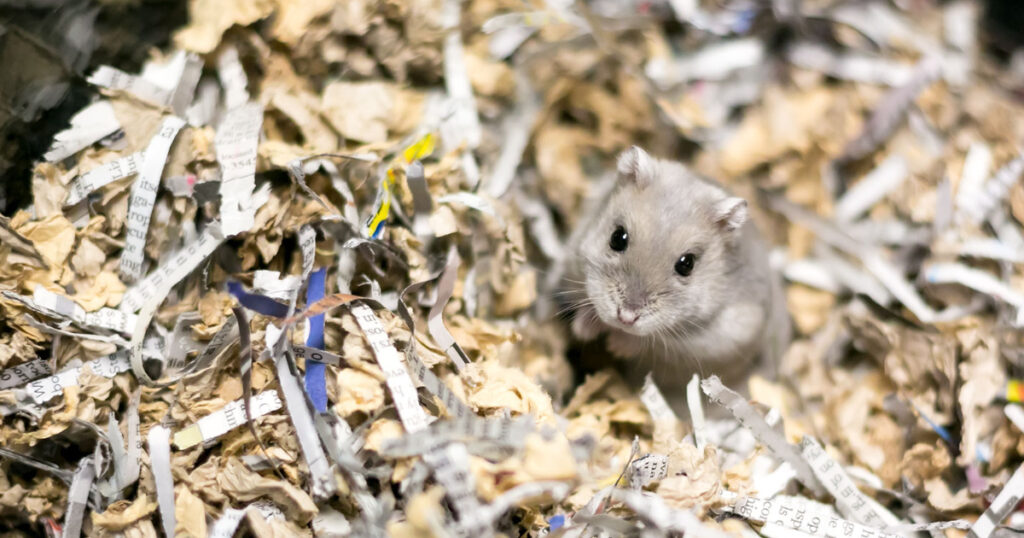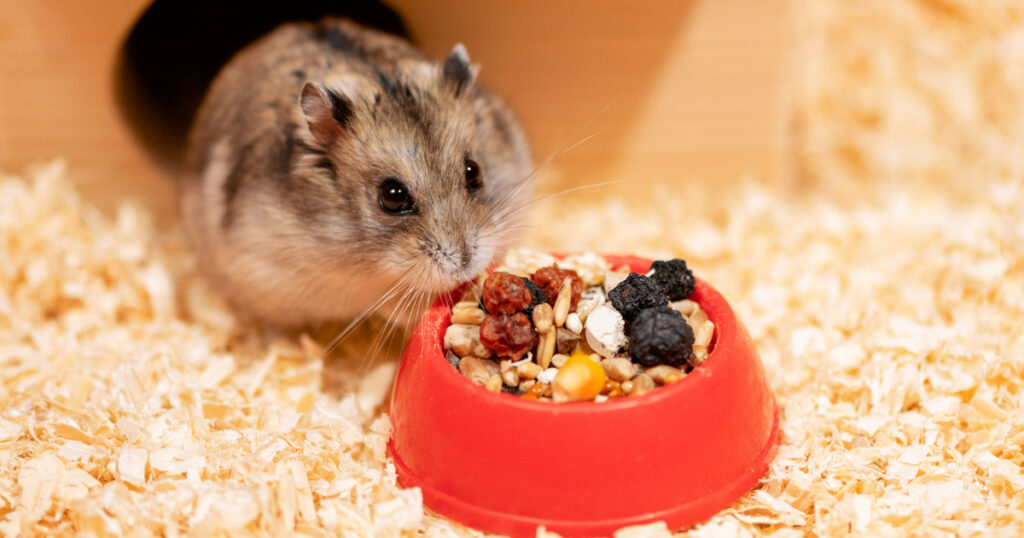Reptile sand is a popular substrate for pet reptiles but poses major health hazards for small animals like hamsters. We will examine the respiratory dangers, impaction risks, eye injuries, dehydration, and tissue mineralization that can occur when using calcium-sand bedding for hamsters. We’ll also overview safer substrate alternatives to avoid these sand-related risks.
What Is Reptile Sand
Reptile sand is a common substrate for lizards, snakes, and other reptiles. Its high calcium content helps promote healthy bone growth. Reptile sand comes in various grain sizes and textures, typically made from calcium carbonate. With its desert-like appearance, it creates a naturalistic environment for reptiles.
However, reptile sand poses significant health risks for hamsters and other small pets. The fine particles can lead to respiratory irritation, intestinal impaction, and even death if proper precautions aren’t taken. There are much safer substrates specifically made for hamsters than taking the risks of using calcium sands.
Respiratory Dangers of Reptile Sand for Hamsters
One major hazard of reptile sand is the risk of respiratory issues in hamsters. When sand particles become airborne, inhaling the fine dust can cause significant irritation to the nasal passages and lungs.
Hamsters are obligate nasal breathers. This means they breathe solely through their nose and lack a diaphragm to filter airborne particles. Calci-sand particles breathed into a hamster’s nasal cavities can scratch and inflame the sensitive tissue.
Prolonged respiratory irritation from calci-sand may induce asthma-like symptoms of wheezing, sneezing, and labored breathing in hamsters. In severe cases, airway inflammation can progress to pneumonia.
Using very finely-grained reptile sand substantially amplifies these respiratory risks. The smaller the sand grains, the deeper they can penetrate the hamster’s lungs when inhaled. This causes considerably more harm than coarser particles.
Some brands market their calcium carbonate sands as a healthier alternative to silica sands. However, inhaling excess calcium still poses hazards. It carries the risk of hypercalcemia, causing calcification in the lungs and air sacs.
Gastrointestinal Blockages from Ingesting Reptile Sand
Another danger of reptile sand is the risk of impaction and gastrointestinal blockage. Although hamsters don’t intentionally eat substrate, they inevitably ingest small amounts when grooming and rooting around their habitat.
When a hamster consumes reptile sand orally, the calcium carbonate absorbs moisture inside the gut. This causes the sand to harden and clump together, potentially forming an obstructive mass.
The sand clumps can become lodged anywhere along the intestinal tract, fully blocking the pathway. This cuts off the blood supply to that intestinal segment, depriving it of oxygen.
A severely obstructed intestine will require emergency surgical removal to save the hamster’s life. However, the prognosis is often poor, even with rapid treatment.
For hamsters who survive an initial impaction, the obstruction risk remains. Reptile sand grains stuck in the lining of the intestines can act as a nidus for future blockages.
Signs of intestinal distress from reptile sand ingestion include:
- Loss of appetite
- Lethargy
- Abdominal swelling or distension
- Painful abdomen when touched
- Straining to pass stool with no output
The finer the calcium sand grains, the more easily they can clog up a hamster’s intestines. So fine powdery reptile sand poses the greatest impaction hazards.
Eye Injuries from Kicked-up Sand
Hamsters are highly active pets that love to burrow, dig, and tunnel through their bedding. They regularly fling grains into the air with their paws and feet when kept on a sandy substrate.
Being hit in the eye by flying sand can cause several injuries:
- Corneal abrasions – Scratches on the eye’s surface that cause significant pain and sensitivity to light.
- Conjunctivitis – Inflammation of the moist tissue lining the eye, causing redness, swelling and discharge.
- Corneal ulcers – Damage to the cornea that erodes the surface, which can lead to blindness if untreated.
- Eyelid trauma – Cuts, tears or scratches on the delicate eyelid skin that may require surgical repair.
Hamsters have large prominent eyes that vulnerability protrude from the head, making them prone to substrate-related damage. Sand grains forcefully ejected by digging paws can scratch the sensitive cornea upon impact.
Any eye injury causes significant pain and impairs vision. Left untreated, sand-induced eye trauma can progress to blindness or loss of the eye.
So reptile sand poses an avoidable risk of damaging the cornea through its repeated ejection by the hamster.
Risk of Dehydration
Reptile calcium sands are incredibly absorbent by design. They help soak up messes and waste to clean a reptile’s habitat. However, this absorbency poses a hazard for small animals like hamsters.
The sand rapidly absorbs any moisture inside the enclosure, including what’s excreted by the hamster. The air soon becomes extremely dry. This constant desiccation increases the hamster’s risk of dehydration.
Dehydration causes electrolyte imbalances, kidney stress, dry skin, and lethargy. It can even become life-threatening without adequate fluids. Diarrhea or wet tail disease exacerbates dehydration risks.
Hamsters get some water content from their food. But reptile sand strips away that dietary moisture before the food reaches their mouth. Walking across the parched substrate to reach the food bowl leads to water loss through the paw pads.
To counteract the drying effects, the habitat needs very high ambient humidity. But sustained high humidity facilitates bacterial and fungal overgrowth in the sand.
Either the hamster suffers the effects of dehydration, or the sand environment cultivates harmful microbes.
Mineralization of Hamster Tissues
The excess calcium content of reptile sands creates another problem – calcification of body tissues. Any calcium carbonate absorbed through the skin or ingested in large doses can deposit in hamster organs.
The kidneys normally regulate serum calcium levels. But frequent contact with calcium-rich sand can overwhelm the kidneys. Excess calcium then builds up in soft tissues like the heart, lungs, eyes, skin and blood vessels.
This abnormal mineralization interferes with normal organ function, ultimately causing organ failure. Hamsters with mineralized lungs essentially suffocate as respiration fails.
Some signs of ectopic calcium deposition include:
- Skin hardening and thickening
- Hard nodules under the skin
- White film over the eye (corneal calcification)
- Heart arrhythmias
- Kidney dysfunction
Calci-sands are formulated to meet the nutritional needs of reptiles which require high dietary calcium. But prolonged exposure wreaks havoc in hamsters not adapted to process such extreme calcium loads.
Precautions When Using Reptile Sand for Hamsters
Given all these significant risks, reptile sand should not be used for hamsters.
However, if choosing to use it, take the following precautions to reduce health hazards:
- Select only coarse-grain sand and avoid fine particulate sand. Larger grains are less likely to cause impaction.
- Spot-clean the habitat daily to remove all soiled sand. Change it completely at least twice weekly.
- Provide a designated shallow dust bath filled with sand rather than making it the main substrate. Limit exposure.
- Supervise all playtime outside the cage extremely closely to prevent ingestion.
- Never feed the hamster on sandy surfaces. Always use a bowl to prevent sand from sticking to the food.
- Weigh the hamster weekly for any signs of GI impaction or dehydration issues.
- Monitor the hamster’s respiratory rate and effort. Seek vet care for any breathing changes.
- Rinse the eyes immediately if the sand makes contact. Flushing with saline prevents scratches.
- Increase fresh foods and access to water to counteract sand’s drying effects.
Safer Substrate Alternatives for Hamsters
Luckily there are many safer, hamster-friendly substrates to use instead of taking the risks of reptile sand.
Recommended options include:
Paper Bedding

- Very soft texture, gentler on paws than sand
- Made from recycled paper pulp materials
- Available in different sizes from flakes to pellets
- Good absorption of waste
- Minimal dust compared to sand
Popular paper bedding brands like Kaytee Clean & Cozy and Carefresh are suitable for hamsters.
Aspen Wood Shavings

- Naturally absorbent to keep enclosure dry
- Allows digging but particles are too large to cause impaction
- Chewable texture helps wear down teeth
- Adds enriching scent
- Ensure no added oils or resins
Aspen shavings specifically are safest, as pine and cedar can be toxic.
Fabric Liners or Fleece
- Zero risk of ingestion, eye injury or dust inhalation
- Wicks away moisture to prevent dampness
- Provides secure footing for little hamster feet
- Reusable and washable for cost savings
- Lacks burrowing and foraging opportunity of loose substrates
Great option for hamsters who are recuperating from illness.
Recycled Paper Pellets
- Highly absorbent of urine and odor
- Soft pellets prevent eye scratches
- Natural unbleached paper appeals to chewing instinct
- Need spot cleaning of soiled areas
Examples are brands like Small Pet Select and ExquisiCat.
Orchard or Timothy Hay
- Provides fiber and forage enrichment
- Soft and pliable texture
- Digging through hay satisfies natural burrowing need
- Young orchard grass has thicker blades than timothy
Combine with another substrate to avoid waste matting.
With numerous safe options, there is no need to risk a hamster’s health by using reptile sand. Stick to substrates made for small animals instead.
Conclusion
In summary, calci-sand substrates created for reptiles should be avoided for hamster enclosures. The multitude of respiratory, gastrointestinal, ocular and hydration risks outweigh any potential benefits.
Fortunately there are many safer loose or absorbent substrates specifically formulated for small animals. Opt for beddings like paper pulp, aspen shavings, fabric liners or paper pellets instead to protect hamster health.
FAQ
Can hamsters safely use calci-sand?
No, reptile calci-sand poses major health risks for hamsters including respiratory issues, intestinal impaction, eye injuries, dehydration and tissue mineralization. It should be avoided.
What substrates are safe for hamsters?
Recommended safe substrates for hamsters include paper bedding, aspen wood shavings, fabric liners, recycled paper pellets and timothy/orchard grass hay. These create a diggable environment without health hazards.
Why is reptile sand dangerous for hamsters?
The fine sand particles can cause respiratory irritation when inhaled. Calcium carbonate sand also absorbs moisture in the gut, hardening into obstructive clumps if ingested. And the excess calcium can deposit in hamster organs.
Can I just use a small amount of reptile sand?
No, even limited exposure poses risks. Providing a designated sand bath rather than loose substrate may reduce risks somewhat. But any contact with calcium carbonate sand brings hazards.
How can I avoid sand impaction in my hamster?
Preventing impaction requires avoiding reptile sands entirely. Use alternative beddings without any sand particles. Also feed hamsters in a bowl on a solid surface, never over sand. Monitor closely for signs of intestinal distress.

